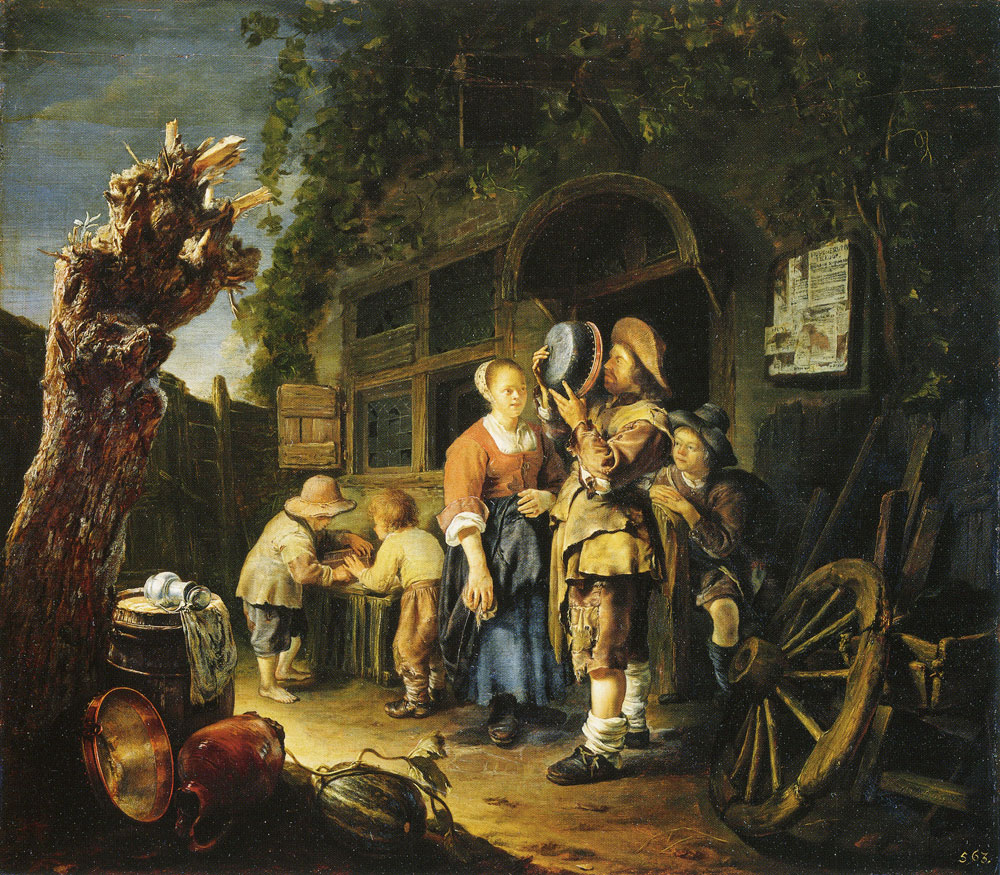author: Hohbach (lithographer), Carl Flemming (publisher)
provenance: original based on a painting by Frans van Mieris; relic obtained in Kwidzyn
time of creation: mid. 19th century
material: paper
technique: printing
dimensions: 40 x 45 cm
former inventory number: W. Pr. 653
date of loss of the monument: 1945
In 1925, a color lithograph was purchased for the collection of the Regional Museum of West Prussia in Kwidzyn, based on the painting Der Kesselflicker by Frans van Mieris. It was acquired from FreuleinDennwitz for the amount of 25 marks. According to the city’s address book from 1926, Augusta Dennwitz lived in Kwidzyn at Salatereistrasse 20. She was unmarried, as evidenced by the note Freulein. Earlier censuses at the same address mentioned another woman, Wilhelmina Dennwitz, who was a housewife. It was probably Augusta’s mother.
The acquired monument was interesting both in terms of the technique used and the subject matter undertaken. This is an example of chromolithography invented in the 19th century. The author of the work was Hohbach. Unfortunately, the curator did not record the name, which makes full verification difficult. In the 19th century, at least a few artists of the same name were involved in color lithography. The publisher of the work was most likely Carl Flemming, who had been operating in Głogów since the 1830s.
The original of the painting “Der Kesselflicker” on the basis of which the lithography was created is undoubtedly an interesting example of Dutch painting of the golden age. Currently, it is in the Old Masters Gallery in Dresden. Its creator was Frans van Mieris the Elder (1635–1681). Coming from a jeweler family, the Dutchman spent most of his life in Leiden. He preferred drawing and painting to goldsmithing. It is worth noting that he achieved artistic maturity relatively quickly. He was one of the few whohad no problems with finding a patron for themselvesduring their artistic activity. Unfortunately, luck failed him in managing the acquired property. The abuse of alcohol greatly contributed to the artist’s premature death. Frans van Mieries specialized in documenting everyday life and portraiture. The specificity of his paintings was also the use of a rather small form, not exceeding several dozen centimeters. Currently, 80 of his works are known.
The lithography purchased for the Kwidzyn museum depicts the eponymous tinker (German: der Kesselflicker), i.e. a craftsman repairing boilers, accompanied by a woman and children nearby. In the foreground, the artist placed an old dead tree, scattered dishes, and a broken wheel. The background was a wooden and brick building covered with greenery from the top. A group of characters occupied the central part of the work. It is worth noting that the picture had several levels of communication. In addition to the direct one, it also hid a rich symbolism related to with the 17th-century political situation in the Netherlands.
The curator of the Kwidzyn museum collected evidence of crafts that were forgotten in the first half of the 20th century. They included, among others the profession of a tinker. While repairing pots was previously a fairly common way to extend the life of the cookware, in times of prevailing cheap factory production, it must have started to fade away. The situation was similar with lithography, which developed very quickly in the 19th century, but in the first decades of the next century it began to give way to new techniques.
The lithograph purchased for the museum collections was by all means a valuable testimony of a bygone era. It was a product of its time, just like its prototype, which lithographers used two centuries later. Hohbach was not the only one to benefit from the work of Frans van Mieris. However, it is difficult to determine whether and to what extent the hidden message was still legible at that time.
The lithograph was lost in 1945. Fortunately, the original of the painting has survived to this day.
Literature:
Inventory book of HeimatmuseumWestpreussen in Marienwerder, item 653, p. 54; Das MarienwerderAdressbuch 1917, p. 13; Das Marienwerder Adressbuch 1926, p. 16
https://www.britishmuseum.org/collection/image/1613015080 (20/07/2021)
https://www.nga.gov/collection/artist-info.5998.html (accessed on July 20, 2021)
https://www.bol.com/nl/nl/p/frans-van-mieris-der-kesselflicker/9200000096712424/ (20/07/2021)
https://www.bod.de/booksample?json=http%3A%2F%2Fwww.bod.de%2Fgetjson.php%3Fobjk_id%3D2415991%26hash%3D5bac8b04dd40ea5423f7ca9af41a6ada (07/22/2021)
http://www.glogow.pl/tzg/bibioteka_mulimedialna/ezg/9.pdf (07/21/2021)
(compiled by J. Jezierska)


